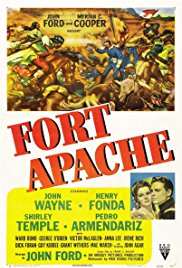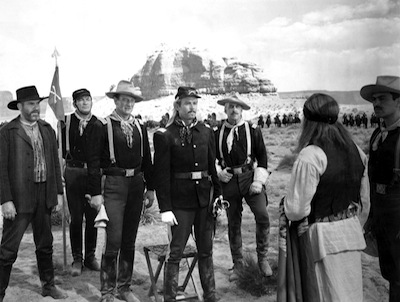FORT APACHE
SUBJECTS — U.S./The Frontier and the West & Arizona;
SOCIAL-EMOTIONAL LEARNING — Courage in War;
MORAL-ETHICAL EMPHASIS — Trustworthiness; Respect.
AGE; 8+; No MPAA Rating;
Drama; 1948; 127 minutes; Color.
There is NO AI content on this website. All content on TeachWithMovies.org has been written by human beings.

SUBJECTS — U.S./The Frontier and the West & Arizona;
SOCIAL-EMOTIONAL LEARNING — Courage in War;
MORAL-ETHICAL EMPHASIS — Trustworthiness; Respect.
AGE; 8+; No MPAA Rating;
Drama; 1948; 127 minutes; Color.
One of the Best! This movie is on TWM’s short list of the best movies to supplement classes in United States History, High School Level.
TWM offers the following movie worksheets to keep students’ minds on the film and to focus their attention on the lessons to be learned from the movie.
Film Study Worksheet for a Work of Historical Fiction; and
Worksheet for Cinematic and Theatrical Elements and Their Effects.
Teachers can modify the movie worksheets to fit the needs of each class. See also TWM’s Historical Fiction in Film Cross-Curricular Homework Project.
An officer from the East takes command of a small fort deep in Indian territory. Smarting from a post-Civil War demotion and assignment to an inferior post, he hopes that a battle with the Apaches will result in a promotion. The officer gets his battle but it’s not what he thought it would be.
Selected Awards:
None.
Featured Actors:
John Wayne, Henry Fonda, Shirley Temple, Pedro Armendariz, Sr., Victor McLaglen, Ward Bond, George O’Brien, Anna Lee.
Director:
John Ford.

This movie accurately shows camp life, entertainment, and military politics on a U.S. Army outpost in the Southwest during the years after the Civil War. The Apaches are portrayed with respect. The false and dishonorable manner in which the U.S. government treated Native Americans is not glossed over. Some of the dialogue with the Apaches is in Spanish.
MINOR. The fight with the Apaches is not entirely realistic. They didn’t fight en mass as shown in the movie. Their custom was to attack in raiding parties of less than 100 warriors.
Some of the lower level officers live to drink various alcoholic beverages.
Tell your children the substance of the Benefits and Possible Problems sections of this Guide. Then ask the Quick Discussion Question.
Indian agents were political appointees. Often the agents were corrupt and didn’t give the Indians the supplies they were promised. Often, the Indian Agents sold whiskey to their charges. Indian tribes were known to have left reservations because of the corruption of the Indian Agents.
Cochise (died 1874) was at first friendly to whites. But in 1862, soldiers executed several members of his family. He turned hostile and for nearly ten years terrorized whites in the Arizona territory. Cochise’s attacks were brilliantly conceived and savage. After the Civil War, U.S. troops moved against him in force. Cochise surrendered in 1871. When he was ordered to take his tribe to a reservation in New Mexico he refused and escaped to Mexico with a few hundred followers. The next year, at a peace conference, he agreed to take his Chiricahua people to a reservation in Arizona where he lived out his life.
After the Civil War the U.S. Army demobilized a million men in a year. There were wholesale demotions of officers and the pay for soldiers, a miserable $16 per month, was cut to $13 a month by a Congress eager to save money. It is quite conceivable that Sergeant O’Rourke (Mickey’s father) could have enlisted during the Civil War, received several battlefield promotions so that he held a high rank, only to be reduced to a sergeant during the wholesale demotions that took place after the war.
At the time portrayed by this film, the U.S. Army had a rigid class system that prohibited association and intermarriage between officers or their families and enlisted personnel. The only permitted social relationship between these classes took place in formal, strictly controlled settings such as the enlisted men’s dance shown in the movie. Colonel Thursby was probably correct when he told his daughter that if she married the son of an enlisted man it would ruin her reputation and endanger her future husband’s career. The modern U.S. Army still has customs and rules against fraternization between officers and enlisted personnel. See Uniform Code of Military Justice, Article 134.
1. See Discussion Questions for Use With any Film that is a Work of Fiction.
2. Colonel Thursby takes note that Cochise was well known in the East and often mentioned in the Eastern newspapers. What role does this play in the plot?
3. Who was responsible for the loss of the battle with Cochise?
4. Why did Colonel Thursby forbid his daughter to marry Lt. O’Rourke?
5. Colonel Thursby called Cochise an “illiterate, uncivilized, murdering, treaty breaking savage.” Was there any basis for this charge?
6. What are the reasons for the military’s rule against fraternization between officers and enlisted men?
1. Is it a courageous act to underestimate your enemy and to put your men to needless risk?
Discussion Questions Relating to Ethical Issues will facilitate the use of this film to teach ethical principles and critical viewing. Additional questions are set out below.
(Be honest; Don’t deceive, cheat or steal; Be reliable — do what you say you’ll do; Have the courage to do the right thing; Build a good reputation; Be loyal — stand by your family, friends, and country)
1. At the end of the movie, Captain York lied to the reporter about Colonel Thursby. Why did Captain York do this? How could you have handled that situation and still complied with your obligation to be honest and not to be deceitful? In your answer, apply the Ethical Decision-Making Model suggested by the Josephson Institute of Ethics. See Making Ethical Decisions.
(Treat others with respect; follow the Golden Rule; Be tolerant of differences; Use good manners, not bad language; Be considerate of the feelings of others; Don’t threaten, hit or hurt anyone; Deal peacefully with anger, insults, and disagreements)
2. What price did Colonel Thursby and his men pay for Thursby’s failure to respect Cochise?
A book intended for adults but suitable for children in the 7th – 9th grades is Killdeer Mountain by Dee Brown. For books dealing with the Indian experience in being forced onto reservations see: The Trail of Tears by David Freemon (the forced migration of Cherokees to the west); Wounded Knee: An Indian History of the American West by Amy Ehrlich (adapted from Dee Brown’s Bury My Heart at Wounded Knee) and Indian Chiefs by Russell Freedman. A book about black soldiers during this period that is suitable for middle school and junior high readers is The Forgotten Heroes: The Story of the Buffalo Soldiers by Clinton Cox.
In addition to websites which may be linked in the Guide and selected film reviews listed on the Movie Review Query Engine, the following resources were consulted in the preparation of this Learning Guide:
This Learning Guide was last updated on December 9, 2009.